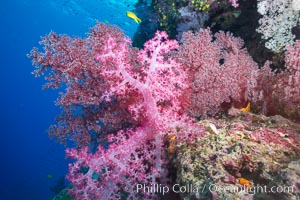
Spectacularly colorful dendronephthya soft corals on South Pacific reef, reaching out into strong ocean currents to capture passing planktonic food, Fiji.
Species: Dendronephthya soft coral, Dendronephthya
Location: Namena Marine Reserve, Namena Island, Fiji
Image ID: 31414
Species: Dendronephthya soft coral, Dendronephthya
Location: Namena Marine Reserve, Namena Island, Fiji
Image ID: 31414

Dendronephthya soft corals and schooling Anthias fishes, feeding on plankton in strong ocean currents over a pristine coral reef. Fiji is known as the soft coral capitlal of the world.
Species: Anthias, Dendronephthya soft coral, Dendronephthya, Pseudanthias
Location: Namena Marine Reserve, Namena Island, Fiji
Image ID: 31415
Species: Anthias, Dendronephthya soft coral, Dendronephthya, Pseudanthias
Location: Namena Marine Reserve, Namena Island, Fiji
Image ID: 31415

Colorful dendronephthya soft corals and various hard corals, flourishing on a pristine healthy south pacific coral reef. The soft corals are inflated in strong ocean currents, capturing passing planktonic food with their many small polyps.
Species: Dendronephthya soft coral, Dendronephthya
Location: Namena Marine Reserve, Namena Island, Fiji
Image ID: 31417
Species: Dendronephthya soft coral, Dendronephthya
Location: Namena Marine Reserve, Namena Island, Fiji
Image ID: 31417

Soft corals (gorgonians, dendronephthya) and hard corals cover a pristine and beautiful south Pacific coral reef, Fiji.
Species: Black sun coral, Dendronephthya soft coral, Gorgonian, Dendronephthya, Gorgonacea, Tubastrea micrantha
Location: Namena Marine Reserve, Namena Island, Fiji
Image ID: 31418
Species: Black sun coral, Dendronephthya soft coral, Gorgonian, Dendronephthya, Gorgonacea, Tubastrea micrantha
Location: Namena Marine Reserve, Namena Island, Fiji
Image ID: 31418

Lyretail Anthias (Pseudanthias squamipinnis). Pink Anemonefish (Amphiprion perideraion) and Magnificent Anemone (Heteractis sp) over South Pacific Coral Reef.
Species: Anthias, Pink anemonefish, Amphiprion perideraion, Pseudanthias
Location: Namena Marine Reserve, Namena Island, Fiji
Image ID: 31419
Species: Anthias, Pink anemonefish, Amphiprion perideraion, Pseudanthias
Location: Namena Marine Reserve, Namena Island, Fiji
Image ID: 31419

Sinularia flexibilis finger leather soft coral, Fiji.
Species: Sinularia soft coral, Sinularis flexibilis
Location: Namena Marine Reserve, Namena Island, Fiji
Image ID: 31420
Species: Sinularia soft coral, Sinularis flexibilis
Location: Namena Marine Reserve, Namena Island, Fiji
Image ID: 31420

Plexauridae sea fan or gorgonian on coral reef. This gorgonian is a type of colonial alcyonacea soft coral that filters plankton from passing ocean currents.
Species: Gorgonian, Sea fan, Gorgonacea, Plexauridae
Location: Namena Marine Reserve, Namena Island, Fiji
Image ID: 31421
Species: Gorgonian, Sea fan, Gorgonacea, Plexauridae
Location: Namena Marine Reserve, Namena Island, Fiji
Image ID: 31421
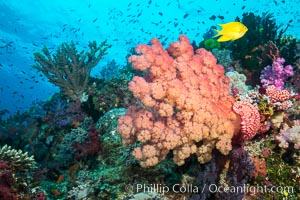
Dendronephthya soft coral inflated in ocean current, filtering plankton, Fiji.
Species: Dendronephthya soft coral, Dendronephthya
Location: Namena Marine Reserve, Namena Island, Fiji
Image ID: 31422
Species: Dendronephthya soft coral, Dendronephthya
Location: Namena Marine Reserve, Namena Island, Fiji
Image ID: 31422

Dendronephthya soft corals and schooling Anthias fishes, feeding on plankton in strong ocean currents over a pristine coral reef. Fiji is known as the soft coral capitlal of the world.
Species: Anthias, Dendronephthya soft coral, Dendronephthya, Pseudanthias
Location: Namena Marine Reserve, Namena Island, Fiji
Image ID: 31423
Species: Anthias, Dendronephthya soft coral, Dendronephthya, Pseudanthias
Location: Namena Marine Reserve, Namena Island, Fiji
Image ID: 31423
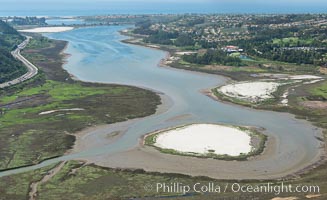
Aerial photo of Batiquitos Lagoon, Carlsbad. The Batiquitos Lagoon is a coastal wetland in southern Carlsbad, California. Part of the lagoon is designated as the Batiquitos Lagoon State Marine Conservation Area, run by the California Department of Fish and Game as a nature reserve.
Location: Carlsbad, Callifornia
Image ID: 30563
Location: Carlsbad, Callifornia
Image ID: 30563
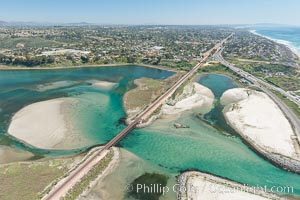
Aerial photo of Batiquitos Lagoon, Carlsbad. The Batiquitos Lagoon is a coastal wetland in southern Carlsbad, California. Part of the lagoon is designated as the Batiquitos Lagoon State Marine Conservation Area, run by the California Department of Fish and Game as a nature reserve.
Location: Carlsbad, Callifornia
Image ID: 30569
Location: Carlsbad, Callifornia
Image ID: 30569
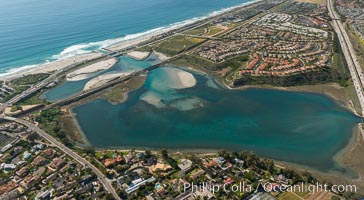
Aerial photo of Batiquitos Lagoon, Carlsbad. The Batiquitos Lagoon is a coastal wetland in southern Carlsbad, California. Part of the lagoon is designated as the Batiquitos Lagoon State Marine Conservation Area, run by the California Department of Fish and Game as a nature reserve.
Location: Carlsbad, Callifornia
Image ID: 30665
Location: Carlsbad, Callifornia
Image ID: 30665

Aerial View of Namena Marine Reserve and Coral Reefs, Namena Island, Fiji.
Location: Namena Marine Reserve, Namena Island, Fiji
Image ID: 34687
Panorama dimensions: 4631 x 9150
Location: Namena Marine Reserve, Namena Island, Fiji
Image ID: 34687
Panorama dimensions: 4631 x 9150
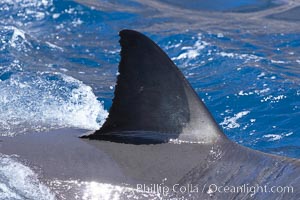
Dorsal fin of a great white shark breaks the surface as the shark swims just below.
Species: Great white shark, Carcharodon carcharias
Location: Guadalupe Island (Isla Guadalupe), Baja California, Mexico
Image ID: 19490
Species: Great white shark, Carcharodon carcharias
Location: Guadalupe Island (Isla Guadalupe), Baja California, Mexico
Image ID: 19490

Great white shark, dorsal fin extended out of the water as it swims near the surface.
Species: Great white shark, Carcharodon carcharias
Location: Guadalupe Island (Isla Guadalupe), Baja California, Mexico
Image ID: 21353
Species: Great white shark, Carcharodon carcharias
Location: Guadalupe Island (Isla Guadalupe), Baja California, Mexico
Image ID: 21353

Great white shark, underwater.
Species: Great white shark, Carcharodon carcharias
Location: Guadalupe Island (Isla Guadalupe), Baja California, Mexico
Image ID: 21358
Species: Great white shark, Carcharodon carcharias
Location: Guadalupe Island (Isla Guadalupe), Baja California, Mexico
Image ID: 21358

Great white shark, underwater.
Species: Great white shark, Carcharodon carcharias
Location: Guadalupe Island (Isla Guadalupe), Baja California, Mexico
Image ID: 21359
Species: Great white shark, Carcharodon carcharias
Location: Guadalupe Island (Isla Guadalupe), Baja California, Mexico
Image ID: 21359

California sea lion.
Species: California sea lion, Zalophus californianus
Location: Guadalupe Island (Isla Guadalupe), Baja California, Mexico
Image ID: 02981
Species: California sea lion, Zalophus californianus
Location: Guadalupe Island (Isla Guadalupe), Baja California, Mexico
Image ID: 02981

Northern elephant seal underwater at Guadalupe Island.
Species: Elephant seal, Mirounga angustirostris
Location: Guadalupe Island (Isla Guadalupe), Baja California, Mexico
Image ID: 03508
Species: Elephant seal, Mirounga angustirostris
Location: Guadalupe Island (Isla Guadalupe), Baja California, Mexico
Image ID: 03508

A great white shark bearing a white plastic researcher's identification ID tag near its dorsal fin swims through the clear waters of Isla Guadalupe, far offshore of the Pacific Coast of Baja California. Guadalupe Island is host to a concentration of large great white sharks, which visit the island to feed on pinnipeds and tuna.
Species: Great white shark, Carcharodon carcharias
Location: Guadalupe Island (Isla Guadalupe), Baja California, Mexico
Image ID: 07739
Species: Great white shark, Carcharodon carcharias
Location: Guadalupe Island (Isla Guadalupe), Baja California, Mexico
Image ID: 07739

Sea otters mating. The male holds the female's head or nose with his jaws during copulation. Visible scars are often present on females from this behavior. Sea otters have a polygynous mating system. Many males actively defend territories and will mate with females that inhabit their territory or seek out females in estrus if no territory is established. Males and females typically bond for the duration of estrus, or about 3 days.
Species: Sea otter, Enhydra lutris
Location: Elkhorn Slough National Estuarine Research Reserve, Moss Landing, California
Image ID: 21606
Species: Sea otter, Enhydra lutris
Location: Elkhorn Slough National Estuarine Research Reserve, Moss Landing, California
Image ID: 21606

Guadalupe fur seals resting.
Species: Guadalupe fur seal, Arctocephalus townsendi
Location: Guadalupe Island (Isla Guadalupe), Baja California, Mexico
Image ID: 02106
Species: Guadalupe fur seal, Arctocephalus townsendi
Location: Guadalupe Island (Isla Guadalupe), Baja California, Mexico
Image ID: 02106

Guadalupe fur seal, hauled out upon volcanic rocks along the shoreline of Guadalupe Island.
Species: Guadalupe fur seal, Arctocephalus townsendi
Location: Guadalupe Island (Isla Guadalupe), Baja California, Mexico
Image ID: 21350
Species: Guadalupe fur seal, Arctocephalus townsendi
Location: Guadalupe Island (Isla Guadalupe), Baja California, Mexico
Image ID: 21350

A great white shark is countershaded, with a dark gray dorsal color and light gray to white underside, making it more difficult for the shark's prey to see it as approaches from above or below in the water column. The particular undulations of the countershading line along its side, where gray meets white, is unique to each shark and helps researchers to identify individual sharks in capture-recapture studies. Guadalupe Island is host to a relatively large population of great white sharks who, through a history of video and photographs showing their countershading lines, are the subject of an ongoing study of shark behaviour, migration and population size.
Species: Great white shark, Carcharodon carcharias
Location: Guadalupe Island (Isla Guadalupe), Baja California, Mexico
Image ID: 19468
Species: Great white shark, Carcharodon carcharias
Location: Guadalupe Island (Isla Guadalupe), Baja California, Mexico
Image ID: 19468

A great white shark swims through the clear waters of Isla Guadalupe, far offshore of the Pacific Coast of Baja California. Guadalupe Island is host to a concentration of large great white sharks, which visit the island to feed on pinnipeds and tuna.
Species: Great white shark, Carcharodon carcharias
Location: Guadalupe Island (Isla Guadalupe), Baja California, Mexico
Image ID: 07667
Species: Great white shark, Carcharodon carcharias
Location: Guadalupe Island (Isla Guadalupe), Baja California, Mexico
Image ID: 07667

A great white shark swims through the clear waters of Isla Guadalupe, far offshore of the Pacific Coast of Baja California. Guadalupe Island is host to a concentration of large great white sharks, which visit the island to feed on pinnipeds and tuna.
Species: Great white shark, Carcharodon carcharias
Location: Guadalupe Island (Isla Guadalupe), Baja California, Mexico
Image ID: 07733
Species: Great white shark, Carcharodon carcharias
Location: Guadalupe Island (Isla Guadalupe), Baja California, Mexico
Image ID: 07733

A great white shark underwater. A large great white shark cruises the clear oceanic waters of Guadalupe Island (Isla Guadalupe).
Species: Great white shark, Carcharodon carcharias
Location: Guadalupe Island (Isla Guadalupe), Baja California, Mexico
Image ID: 10114
Species: Great white shark, Carcharodon carcharias
Location: Guadalupe Island (Isla Guadalupe), Baja California, Mexico
Image ID: 10114

Isla San Pedro Martir at sunset with extensive forest of Cardon Cactus seen on the summit ridge of the island, aerial photo, Sea of Cortez, Mexico. San Pedro Martir Island and its marine life are, since 2002, part of the San Pedro Martir Biosphere Reserve, and is regarded as a natural laboratory of adaptive evolution, similar to that of the Galapagos Islands. It is home to 292 species of fauna and flora (both land-based and aquatic), with 42 species protected by Mexican law, and 30 listed on the Red List of Threatened Species. San Pedro Martir is also unique in the area for its year-round quantity of birds. The island is the only island in the area with a perpetually swirling cloud of sea birds. This is because the water around the island, has some of the most successful marine productivity in the world.
Species: Cardon cactus, Elephant cactus, Pachycereus pringlei
Location: Isla San Pedro Martir, Sonora, Mexico
Image ID: 40398
Species: Cardon cactus, Elephant cactus, Pachycereus pringlei
Location: Isla San Pedro Martir, Sonora, Mexico
Image ID: 40398
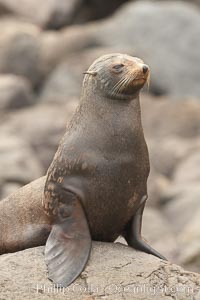
Guadalupe fur seal, hauled out upon volcanic rocks along the shoreline of Guadalupe Island.
Species: Guadalupe fur seal, Arctocephalus townsendi
Location: Guadalupe Island (Isla Guadalupe), Baja California, Mexico
Image ID: 21351
Species: Guadalupe fur seal, Arctocephalus townsendi
Location: Guadalupe Island (Isla Guadalupe), Baja California, Mexico
Image ID: 21351
